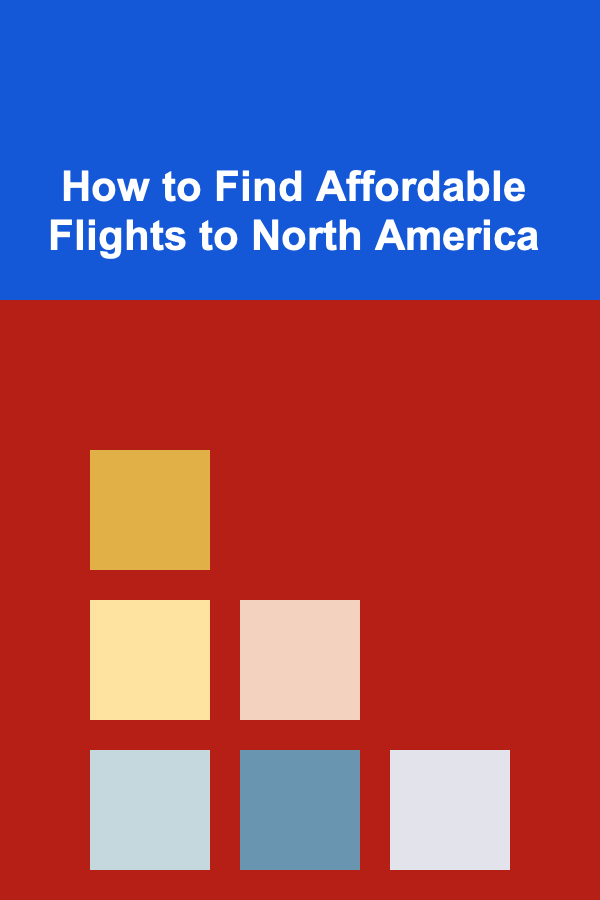
How to Find Affordable Flights to North America
ebook include PDF & Audio bundle (Micro Guide)
$12.99$6.99
Limited Time Offer! Order within the next:

Traveling to North America, with its diverse landscapes and vibrant cities, can be an incredibly rewarding experience. However, the cost of flights can often be a significant barrier. This article provides a comprehensive guide to finding affordable flights to North America, covering everything from the best booking strategies to leveraging lesser-known travel hacks.
Understanding the Dynamics of Airfare Pricing
Before diving into specific strategies, it's crucial to understand the factors that influence airfare prices. Airlines employ complex algorithms that constantly adjust prices based on numerous variables. These factors include:
- Demand: Higher demand, especially during peak seasons (summer, holidays, school breaks), leads to higher prices. Conversely, lower demand during off-peak seasons typically results in cheaper flights.
- Time of Booking: The "Goldilocks Zone" for booking flights is generally believed to be between 2-3 months before departure for domestic flights and 3-6 months for international flights. Booking too early or too late often results in higher prices.
- Day of the Week: Historically, flights departing on Tuesdays, Wednesdays, and Saturdays tend to be cheaper than those departing on Fridays and Sundays, due to lower business travel demand. This trend is becoming less consistent due to algorithm-driven pricing, but it's still worth considering.
- Time of Day: Red-eye flights (departing late at night or arriving early in the morning) and flights with inconvenient layovers are often cheaper because fewer people want them.
- Fuel Prices: While airlines often hedge their fuel costs, fluctuations in global oil prices can still impact airfare, albeit indirectly.
- Competition: Routes served by multiple airlines tend to have more competitive pricing. Consider flying to or from airports with a high concentration of low-cost carriers.
- Seasonal Events: Major events like conferences, festivals, or sporting events can significantly increase demand and prices for flights to the affected cities.
- Airline Sales and Promotions: Airlines regularly offer sales and promotional fares to fill empty seats, especially during shoulder seasons (the periods between peak and off-peak seasons).
- Booking Class: Economy, Premium Economy, Business, and First Class fares all have different price points, with Economy being the most affordable but often restrictive.
Strategic Booking Techniques
Armed with an understanding of airfare dynamics, let's explore practical strategies for finding affordable flights to North America:
1. Be Flexible with Your Travel Dates
This is perhaps the single most effective way to save money on flights. Airlines often price flights differently depending on the day of the week and the time of year. Use flight search engines with calendar views that display prices for entire months. This allows you to easily identify the cheapest days to fly. Consider traveling during the shoulder seasons (spring and fall) when the weather is still pleasant and tourist crowds are thinner.
Tip: Many flight search engines offer a "flexible dates" or "+/- 3 days" option. Utilize this feature to see how shifting your travel dates by a few days can impact the price.
2. Be Flexible with Your Destination
If you're open to exploring different parts of North America, being flexible with your destination can also lead to significant savings. Instead of focusing on a specific city, consider searching for flights to a general region, such as "East Coast USA" or "Western Canada." Once you've found a cheap flight to a nearby airport, you can then explore different cities using local transportation.
Tip: Consider flying into a smaller, regional airport instead of a major international hub. These airports often have lower landing fees, which can translate to cheaper fares.
3. Use Flight Search Engines and Comparison Websites
Don't rely on just one website when searching for flights. Compare prices across multiple flight search engines and online travel agencies (OTAs). Some popular options include:
- Google Flights: Known for its powerful search capabilities and price tracking features. It allows you to explore destinations on a map and set up email alerts for price changes.
- Skyscanner: Offers a "search everywhere" function that allows you to see the cheapest destinations from your departure airport.
- Kayak: Provides price alerts and explores "hacker fares" (booking two one-way tickets on different airlines to save money).
- Momondo: Known for finding unique and less obvious flight combinations.
- Expedia, Priceline, Orbitz: These are popular OTAs that bundle flights with hotels and car rentals for package deals.
Caution: While OTAs can sometimes offer lower prices, be sure to read the fine print regarding cancellation policies and baggage fees. Also, booking directly with the airline often provides better customer service if you need to make changes to your flight.
4. Consider Budget Airlines
North America has several budget airlines that offer significantly lower fares than traditional carriers. However, these airlines often charge extra for everything from checked baggage to seat selection. Factor these fees into your total cost to determine if a budget airline is truly the most affordable option.
Examples of budget airlines in North America include:
- Spirit Airlines: Known for its ultra-low base fares and extensive network within the United States.
- Frontier Airlines: Offers a similar model to Spirit, with unbundled fares and optional add-ons.
- Allegiant Air: Focuses on flying to smaller, leisure destinations from secondary airports.
- Southwest Airlines: While not strictly a budget airline, Southwest often offers competitive fares and includes two free checked bags.
- JetBlue: Offers a good balance between low fares and amenities, such as free Wi-Fi and seatback entertainment. While not a deep discounter like Spirit or Frontier, JetBlue can offer competitive fares especially if booking well in advance.
- Flair Airlines (Canada): A Canadian ultra-low-cost carrier that serves destinations across Canada and some in the United States.
- Swoop (Canada): Another Canadian ultra-low-cost carrier owned by WestJet.
Tip: Read the fine print carefully when booking with a budget airline to understand all applicable fees. Pack light to avoid checked baggage fees, and consider bringing your own snacks and drinks to avoid onboard purchases.
5. Explore Alternative Airports
Major cities often have multiple airports, some of which may be less expensive to fly into or out of. For example, instead of flying into New York City's JFK or LaGuardia, consider Newark (EWR) in New Jersey. Similarly, for Los Angeles, consider flying into Long Beach (LGB) or Burbank (BUR) instead of LAX.
Tip: Use Google Flights to search for flights to multiple airports near your destination. Just enter the city name, and Google Flights will automatically include nearby airports in the search.
6. Take Advantage of Stopovers and Layovers
Flights with stopovers or layovers are often cheaper than direct flights. While a long layover may seem inconvenient, it can also be an opportunity to explore a new city. Some airlines even offer free stopover programs that allow you to spend a few days in their hub city at no extra cost.
Tip: Consider building a "multi-city" itinerary with a deliberately long layover in a city you've always wanted to visit.
7. Consider One-Way Flights
In some cases, booking two one-way flights on different airlines can be cheaper than booking a round-trip ticket. Use flight search engines like Kayak that specialize in finding "hacker fares" (separate one-way tickets). This strategy is particularly effective when flying between destinations with high competition among airlines.
Tip: Be aware that booking separate one-way flights means you're responsible for any missed connections or flight cancellations. If your first flight is delayed and you miss your connecting flight, the airline is not obligated to rebook you.
8. Use Incognito Mode or Clear Your Browser Cache
There's a common belief that airlines track your searches and increase prices when they detect you're repeatedly searching for the same flight. While there's no conclusive evidence to support this theory, it's a good practice to use incognito mode or clear your browser cache and cookies before searching for flights. This prevents websites from tracking your browsing history.
9. Join Airline Loyalty Programs and Credit Card Rewards Programs
Airline loyalty programs allow you to earn miles for every flight you take, which can be redeemed for free flights, upgrades, and other travel benefits. Credit card rewards programs also offer opportunities to earn miles or points that can be transferred to airline loyalty programs. Choose a credit card that aligns with your travel habits and offers bonus points for travel-related purchases.
Tip: Look for credit cards that offer sign-up bonuses after you meet a minimum spending requirement. These bonuses can often be worth thousands of miles or points.
10. Track Flight Prices and Set Up Price Alerts
Flight prices fluctuate constantly, so it's important to track prices over time and set up price alerts. Many flight search engines, such as Google Flights, Kayak, and Skyscanner, offer price tracking features. You can set alerts to receive email notifications when the price of a specific flight drops.
11. Consider Package Deals
Bundling flights with hotels and car rentals can sometimes result in significant savings. Many OTAs offer package deals that are often cheaper than booking each component separately. However, be sure to compare the total cost of the package with the cost of booking each item individually to ensure you're actually getting a good deal.
12. Look for Error Fares
Occasionally, airlines accidentally publish incorrect fares due to human error or system glitches. These "error fares" can be incredibly cheap, but they're often short-lived and difficult to find. Websites like Secret Flying and Scott's Cheap Flights (now Going.com) specialize in finding and publishing error fares. However, be prepared for the possibility that the airline may cancel the ticket if it discovers the error.
13. Book Connecting Flights Yourself (Self-Transfer)
This is a more advanced technique and requires careful planning. Instead of booking a connecting flight through the airline, book separate flights yourself, ensuring you have ample time (at least 3-4 hours) for the connection, including clearing immigration and customs if necessary. This can sometimes save you money, but it also comes with significant risks. If you miss your connecting flight due to a delay on the first flight, you are responsible for rebooking your second flight, and the airline is not obligated to help you.
Caution: Self-transfer connections are only recommended for experienced travelers who are comfortable with the risks involved.
14. Think About Positioning Flights
A positioning flight is when you fly to a different airport (often in a different country) in order to take advantage of cheaper flights from that location. This can be particularly effective if you live near a border or are willing to travel to a major hub airport with more competitive fares. For example, someone living near the Canadian border might find it cheaper to fly out of a US airport, or vice versa. The cost of the positioning flight needs to be factored into the overall cost to determine if it's worthwhile.
15. Last Minute Deals (A Gamble)
While generally, booking well in advance is recommended, sometimes airlines will drastically reduce prices close to the departure date to fill remaining seats. This is a risky strategy as availability is limited, and you might not get your preferred destination or travel times. However, if you are very flexible and spontaneous, checking for last-minute deals can occasionally yield amazing savings. Apps and websites specializing in last-minute travel deals can be helpful.
Specific Strategies for Different Destinations in North America
While the general strategies above apply to all destinations, here are some specific tips for finding affordable flights to popular regions in North America:
Flights to the United States
- East Coast: Consider flying into secondary airports like Providence (PVD) or Manchester (MHT) instead of Boston (BOS), or Baltimore (BWI) instead of Washington, D.C. (IAD or DCA).
- West Coast: Explore flying into Oakland (OAK) or San Jose (SJC) instead of San Francisco (SFO), or Long Beach (LGB) or Burbank (BUR) instead of Los Angeles (LAX). Las Vegas (LAS) often has very competitive fares due to the high volume of flights.
- Florida: Orlando (MCO) and Fort Lauderdale (FLL) are popular destinations served by many budget airlines. Tampa (TPA) is another good option to consider.
- Midwest: Chicago (ORD) and Minneapolis (MSP) are major hubs with frequent flights and competitive fares.
Flights to Canada
- Toronto: Consider flying into Hamilton (YHM) or Kitchener-Waterloo (YKF) instead of Toronto Pearson (YYZ).
- Vancouver: Abbotsford (YXX) is a smaller airport near Vancouver that is often served by budget airlines.
- Montreal: Plattsburgh (PBG) airport in New York is a short drive from Montreal and often has cheaper flights.
- Calgary: Explore flying into Edmonton (YEG) instead of Calgary (YYC), and using ground transportation for the rest of the trip.
Flights to Mexico
- Cancun: A very popular destination with many direct flights from the US and Canada. Check for package deals that include flights and hotels.
- Mexico City: A major hub with a wide range of flight options. Consider flying on a Mexican airline for potentially lower fares.
- Guadalajara: Another major city with frequent flights and competitive pricing.
- Smaller resort towns (Puerto Vallarta, Los Cabos): Often have direct flights, but prices can vary greatly depending on the season.
Conclusion
Finding affordable flights to North America requires a combination of knowledge, flexibility, and persistence. By understanding the dynamics of airfare pricing and implementing the strategies outlined in this article, you can significantly increase your chances of securing a great deal and making your dream trip to North America a reality. Remember to be patient, compare prices across multiple sources, and be willing to adjust your travel plans to take advantage of opportunities for savings. Happy travels!
Reading More From Our Other Websites
- [Home Lighting 101] How to Light Your Home for Better Sleep and Relaxation
- [Organization Tip 101] How to Sort and Store Leftover Ingredients from Meals
- [Personal Investment 101] How to Use Deep Learning to Automate and Monetize Your Business
- [Home Storage Solution 101] How to Transform Your Chaotic Under-Sink Area with the Best Under-Sink Organizers
- [Home Holiday Decoration 101] How to Decorate a Holiday Tree with a Specific Theme: Tips and Ideas
- [Scrapbooking Tip 101] Creative Themes to Inspire Your Child's First Scrapbook
- [Home Budget Decorating 101] How to Use DIY Floor Lamps to Create Ambiance and Save Money on Lighting
- [Personal Care Tips 101] How to Achieve a Voluminous Ponytail with Hair Mousse
- [Home Storage Solution 101] How to Declutter and Store Kids' Toys in a Family-Friendly Way
- [Home Budget 101] How to Create a Budget That Includes Long-Term Savings and Investments

How to Choose the Right Holiday Decor for Your Home's Style
Read More
How to Create a Checklist for Attending a Formal Event
Read More
How to Manage Multiple Rental Properties Without Overwhelm
Read More
How To Wear Animal Print Tastefully
Read More
The Role of AI in Job Applications# The Role of AI in Job Applications: How to Adapt
Read More
How to Choose Between Fat FIRE and Barista FIRE
Read MoreOther Products

How to Choose the Right Holiday Decor for Your Home's Style
Read More
How to Create a Checklist for Attending a Formal Event
Read More
How to Manage Multiple Rental Properties Without Overwhelm
Read More
How To Wear Animal Print Tastefully
Read More
The Role of AI in Job Applications# The Role of AI in Job Applications: How to Adapt
Read More